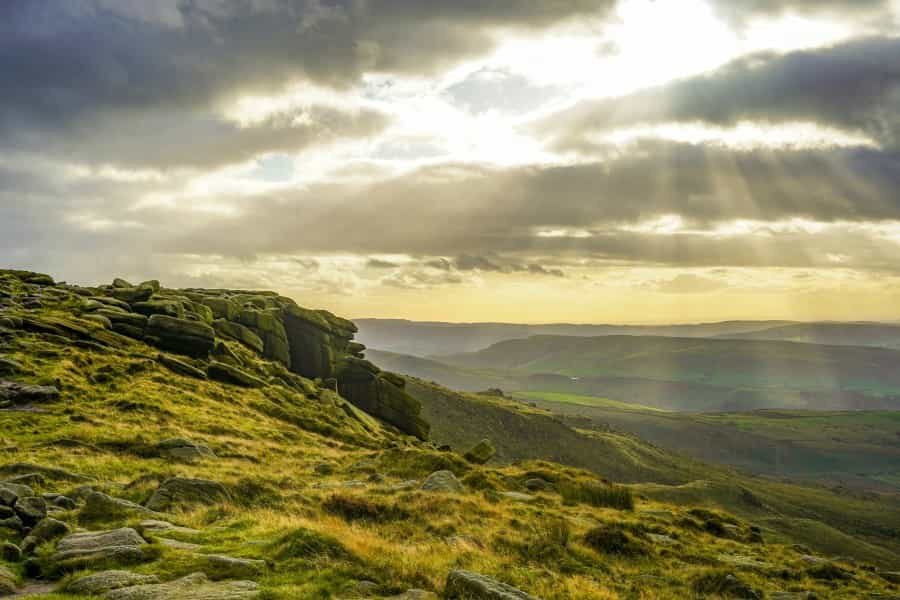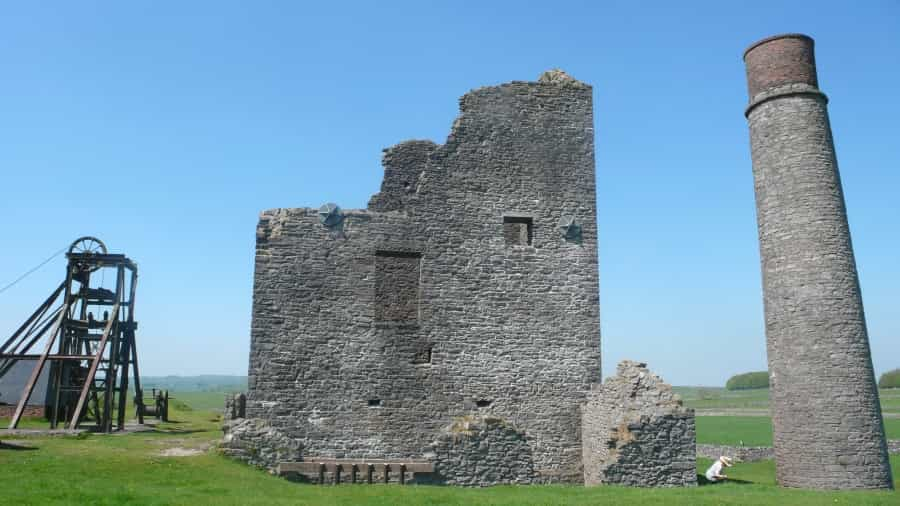Peak District Cultural Highlights

Alongside its beautiful natural landscapes, the Peak District National Park has a rich and varied cultural heritage. If you’re interested in history, architecture or the arts, there’s plenty here to discover. Our guide to Peak District culture takes in historic landmarks and industrial sites, quirky events and markets, as well as a few hidden gems – which will you visit first?
Historical landmarks
Chatsworth House
A magnificent Grade I listed stately home, Chatsworth House has been the residence of the Devonshire family since the 1550s. As well as exploring the house itself and its renowned art collection, on a visit here you can wander the beautiful 105-acre garden and enjoy more than 1800 acres of parkland and woodland which is free to visit throughout the year.
Inside, there are more than 25 rooms to see, including the Painted Hall (with its elaborate 17th-century decorations depicting the life of Julius Caesar), the Oak Room (with ornate 19th-century carved oak panelling), a 17th-century chapel, grand State Rooms and an impressive library. The family’s notable collection of art spans 4,000 years and includes Old Master drawings by Raphael and Leonardo da Vinci as well as an extensive collection of early 19th-century European sculpture.
Dotted with statues, fountains and water features, the grounds feature an arboretum and a rose garden, a family trail, a farmyard with animals to feed and a woodland adventure playground. Both the house and garden are accessible to wheelchair users.
Local tip: Open between March and November, the house hosts regular guided tours and introductory talks, as well as special events and exhibitions, including a Country Fair in summer that attracts thousands of visitors. Details of how to book tickets are available online.
Haddon Hall
More than 900 years old, Haddon Hall is an immaculately preserved medieval manor house set beside the River Wye near Bakewell. Highlights of a visit here include splendid Medieval, Tudor and Elizabethan architecture, notable collections of tapestry and early English furniture, the Long Gallery designed by architect Robert Smythson, a chapel with 15th-century frescoes and a grand Medieval Banqueting Hall.
Outside, the hall’s beautiful Elizabethan Walled Gardens are renowned for their summer roses and have delightful views over the river and the national park, while the surrounding Haddon Medieval Park hosts wildlife walks and tours of its woodland, parkland and meadows.
The house is open to visitors between March and October and runs free guided tours every Monday.
Local tip: The hall’s serene setting and authentic period architecture have made it a popular filming location for numerous movies, including Jane Eyre, Pride and Prejudice and The Princess Bride. Look out for occasional film tours on their calendar of events.
Peveril Castle
Set on a rocky hilltop overlooking Castleton, Peveril Castle was built at the end of the 11th century, with a keep constructed by Henry II in 1174, and was one of England’s earliest Norman fortresses. Primarily used as a hunting and administrative centre, it was abandoned and fell into disrepair in the 16th century and is now a handsome ruin.
A short (but steep) walk up the hill allows you to explore the remains of the keep and other medieval buildings, and rewards you with fabulous panoramic views over the Hope Valley.
A short walk away, the visitor centre is home to displays that explain about the castle’s history, artefacts discovered at the site, plus a car park and a picnic area.
Local tip: There’s a discount on entry if you book in advance online.

Traditional events and festivals
Well dressing
A beloved Peak District tradition, well dressing is an ancient custom thought to have originated as a means of giving thanks for supplies of clean water. It involves decorating wells and springs with elaborate mosaic designs featuring flower petals, ribbons and other natural materials, incorporated in a clay-covered wooden frame. More than 80 sites in and around the park maintain the practice, which is often combined with community fairs and celebrations.
If you’re visiting the park between May and September, these are ‘well’ worth looking out for, either to watch the dressing being constructed, or to view the finished product. The informative Derbyshire Well Dressing website has a comprehensive list of dates, events and locations, with details of how to locate the wells, plus historical information and some great pictures. The Visit Peak District website has a downloadable leaflet that explains more about the custom, with dates for some events.
Buxton International Festival
Held for around two weeks every July, the Buxton International Festival is a popular annual fixture that hosts music and literary events at numerous venues throughout the town, including the Buxton Opera House and the Pavilion Arts Centre. One of the Peak District’s most popular arts and entertainment events, it has a particular focus on rarely performed or unusual operas, often featuring world-class musicians, but also includes literary talks with prominent politicians and authors, theatre productions, art exhibitions, jazz concerts and Morris dancing.
If you’re visiting the area in July, make sure to check the festival’s schedule and book tickets in advance – the most popular events sell out quickly.
Ashbourne Royal Shrovetide Football
Thought to have originated in the 17th century, and another great Peak District tradition, the Royal Shrovetide Football in Ashbourne claims to be one of the world’s oldest football games.
With hundreds of players, no set pitch, goals three miles apart and very few rules (although you might be relieved to hear that ‘no murder’ is one), the match bears little resemblance to football today. It’s more akin to a combination of rugby and a barely controlled riot – local shops and businesses usually board up their windows – but it’s fair to say that it’s the town’s biggest event of the year, and attracts worldwide attention.
The game attracts thousands of players and spectators from 2pm to 10pm every Shrove Tuesday and Ash Wednesday. The raucous atmosphere and community participation make it a must-see if you’re on holiday in the area, and if you’re so inclined, you can even take part.
If you’re interested, the Visit Peak District and Derbyshire website has more details about the game, its history, and what to expect.
Local crafts and markets
If you’d like to pick up a souvenir of your visit to the park, unique handicrafts or something delicious to eat, the Peak District’s markets are the place to go. Here are some of our favourites:
-
Bakewell Market - held every Monday from 9am to 4pm, Bakewell’s popular market is the largest in the Derbyshire Dales, with more than 100 stalls selling local produce, crafts and antiques, as well as food, clothing and household items. It’s also a great place to sample the local delicacy, the Bakewell pudding. Made with puff pastry, jam, almonds and sugar, it’s definitely worth a try, and will give you plenty of extra energy to see you through to your next meal.
-
Chesterfield Flea Market - just outside the park, Chesterfield’s flea market (Thursdays, 9am to 4pm) is particularly strong on vintage items, collectibles and handmade crafts – so it's a great spot if you’re into sustainability or hunting for treasures. Details of how to get there and the items on sale, as well as monthly artisan markets and record fairs, are available on the Visit Chesterfield website.
-
Buxton Market - with stalls selling food, flowers, household items and gifts, Buxton’s regular market takes place on Tuesday and Saturday every week (9am to 4pm), and the town also hosts regular specialist events. For details of monthly food and drink, craft and vintage editions, and the popular Christmas Market, take a look at the Buxton Markets website.
Look out too for exhibitions and open studio events organised by the Peak District Artisans, a local collective producing work inspired by the area that includes pottery, textiles and jewellery.
If you love a spot of leisurely shopping, the Visit Peak District and Derbyshire website has a page that lists both regular and one-off markets and craft fairs held in the region throughout the year.
Cultural hidden gems
Cromford Mills
On the edge of the Peak District National Park and part of the Derwent Valley World Mills Heritage Site, Cromford Mills was the world’s first water-powered cotton spinning mill, and it was here that 18th-century inventor Richard Arkwright’s ideas were first put into practice during the Industrial Revolution.
Today, the site offers guided and audio tours taking in the Mill Yard and the specially built workers’ village nearby, as well as special events led by a costumed guide on the third Sunday of every month.
Inside the mill, The Arkwright Experience is a 3D film that gives you the opportunity to meet the man himself, and in the visitor centre you can watch another film that explores the mill’s history and see some of the original machinery. Take a minute too for a look at the mill's Hydro Power Project, which utilises the mill’s original water source to generate sustainable electric power.
The site itself is free to visit, has independent shops and two cafes, and holds regular events throughout the year, while the riverside area around the mill complex is a great place for a walk, wildlife spotting or a picnic.
Magpie Mine and Temple Mine

For another fascinating glimpse into the industrial heritage of the Peak District, make your way to Magpie Mine. This atmospheric and well-preserved former lead mine in the heart of the park near Bakewell is free to visit, and although the mine shafts themselves are now capped, there’s plenty to see, with extensive remains of mine buildings and machinery including the 19th-century Cornish Engine House.
If you’d love to get underground, you’ll have to venture just outside the park to Matlock Bath, where the Peak District Mining Museum’s site at Temple Mine offers guided tours and the chance to pan for gold. Just across the road, the main museum is home to thousands of rock and mineral specimens, historic photos and documents, mining artefacts including a huge water pressure engine and mock tunnels to climb through – a great way to keep your kids interested while you explore.
Thornbridge Hall
A Grade II listed 12th-century manor house, Thornbridge Hall has been called ‘the quirkiest stately home in the UK’. You’ll have to book a tour to get inside, but then you’ll discover an eclectic selection of Victorian, Gothic and Elizabethan architectural features including a Venetian glass ceiling, elaborately carved woodwork, stained glass windows designed by Arts and Crafts pioneer William Morris and some unusual art.
The hall’s formal 19th-century gardens (open every day from 10am to 4pm) include an Italianate garden and a water garden and are home to three temples, numerous statues, a greenhouse and an orangery, as well as having great views over the park. There are play areas for children, who can also seek out the ‘duck fountain’, follow a trail through the garden and feed farm animals at the estate’s smallholding.
Owned by Jim and Emma Harrison since 2002, the hall is still a private home, and the fact that the tours are conducted by family members gives it a uniquely personal feel.
Whether you want to explore a stately home or a Norman castle, catch a rare opera, descend underground or play football with a thousand others, the Peak District’s cultural sites have something for you. If you'd like to keep costs down and take in some of the area's stunning scenery at the same time, take a look at Pitchup’s best campsites in the Peak District to find a campsite or glampsite that suits your style and budget.
Resources
Official Peak District National Park website